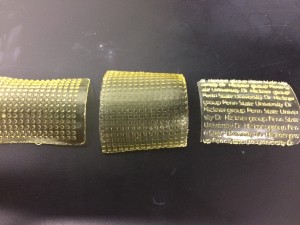3D Print Approach for Membranes

Latest News
June 21, 2016
Ion exchange membranes are used in a number of energy and chemical applications. They transport dissolved ions across a conductive polymeric membrane — a process that can be enhanced using a pattern on the membrane to improve conductivity. Penn State researchers have created a 3D printing method that can help more efficiently create these membranes.
The membranes are used in fuel cells, batteries, water purification,  desalination, food processing and other applications. Traditionally, ion exchange membranes are produced as flat sheets. With 3D patterns integrated into the sheets, however, their performance can be augmented by increasing conductivity and reducing resistance.
desalination, food processing and other applications. Traditionally, ion exchange membranes are produced as flat sheets. With 3D patterns integrated into the sheets, however, their performance can be augmented by increasing conductivity and reducing resistance.
Creating patterned membranes traditionally required using an etched silicon mold, which is an inflexible (only one pattern can be created) and time-consuming process.
“We thought if we could use 3D printing to fabricate our custom-synthesized ion exchange membranes, we could make any sort of pattern and we could make it quickly,” said Michael Hickner, associate professor of materials science and engineering at Penn State.
That’s where’s Penn’s new process comes in. The researchers came up with a custom 3D photolithographic printing process that resembles stereolithography. In this process, a photocurable mixture of ionic polymers is exposed to a light projector to harden the base layer; additional polymer is then projected as a pattern on the material.
“While surface patterned membranes have been studied previously, this is the first 3D printed example of these structures and the first model that really explains the resistance decrease in a quantitative way,” said Lead author and a Ph.D. candidate in materials science and engineering, Jiho Seo. “A simple parallel resistance model describes the effect of the pattern on lowering the resistance of these new membranes. This insight gives us a design tool to continue to innovate and create new patterns for further improvements along with changing the intrinsic chemistry of the material.”
The researchers plan to continue to optimize the geometry and chemistry of the membranes, and develop ways to print with new materials for membranes and other applications.
Penn State’s research was published in the American Chemical Society’s journal ACS Applied Materials and Interfaces. You can read the paper, “3D Printing of Micro-Patterned Anion Exchange Membranes.”
Source: Penn State
Subscribe to our FREE magazine, FREE email newsletters or both!
Latest News
About the Author
Brian Albright is the editorial director of Digital Engineering. Contact him at [email protected].
Follow DE





